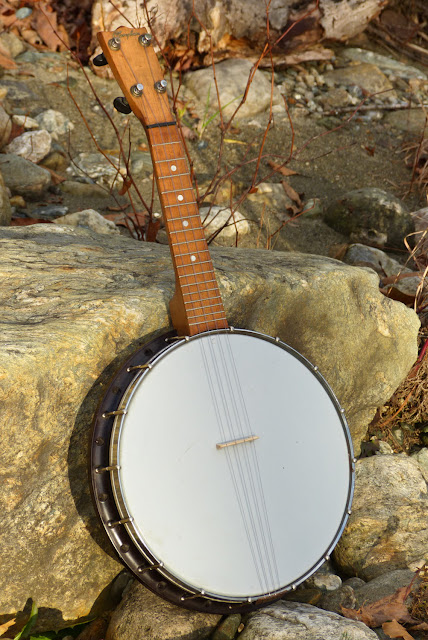1920s/1960s/2016 Big Rim Frankenstein Banjo Ukulele
This monster is a cobbled-together mess of a 1920s Gretsch-made Clarophone soprano banjo uke neck and an 11" some-sort-of-molded-plastic 1960s Harmony banjo rim. Ever wonder what a banjo uke would be like if it had the punch, volume, and carrying power of a resonator tenor banjo? Yeah, that's what this does. It sounds giant and actually sort-of kills my ears in a small room. It would be perfect for acoustic band use if you've got a uke player that's carrying the ka-chuck sound for you.
Anyhow, the neck came to me in trade cobbled to this rim, but I decided to mate it to the Harmony rim because -- one, I thought it'd make it much lighter-weight (it did), and two, I thought the fundamental, woody (ironically) tone of the rim would suit the nylon strings (it does). I don't even have to damp overtones anywhere to get a nice, clear, good tone out of this (something unusual for banjo-ukes).
It's not a beautiful instrument but I do think it has a great "workmanly" aesthetic, it's rugged, and it's a heck of a lot of fun to play. The neck is straight, the frets have been leveled/dressed, the friction pegs work swell, and it plays with spot-on 1/16" action at the 12th fret. For reference, the strings are D'Addario Titaniums and the scale is 13 1/4" long.
Note how Harmony didn't even bother to cut the flash in the extra holes on the rim (intended for extra hooks if need be). This is the original (Remo-made synthetic) head as far as I know and while it has a couple of tiny punctures (see later in the post), it's holding-up just fine.
While the nut isn't original (it's plastic someone put on a while back), the rest is. I replaced one of the tuner shafts (it was bent) with a same-period, same-part, however.
This has a 1 3/8" nut width and a bigger, C-shaped profile. I'm sure it could handle steel but -- why?
It's hard to see in the pics but the maple has a bit of figure in it.
I re-used the original jo-uke tailpiece.
I installed the neck with a couple of over-under "bolts" -- by which I mean drywall screws. Works like a charm!
Here's tiny puncture #1 in the head.
Tiny (pinprick) puncture #2 is directly over the treble side of the bridge in this shot. The other thing is a spec of dirt.
















Comments